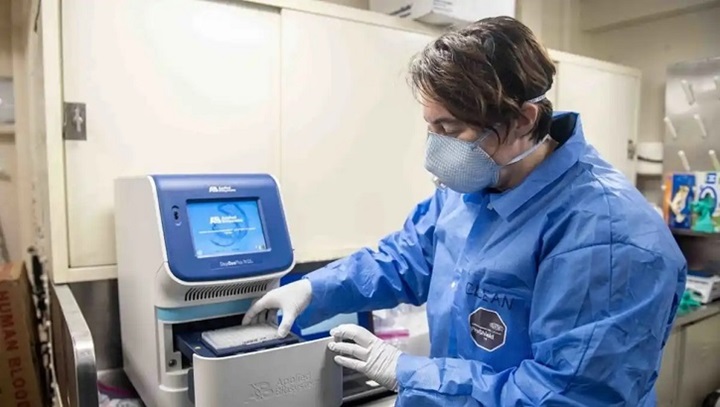Bay Area
UC Berkeley’s Public Health Offers Volunteer Opportunity for Covid-19 Research Study

A team of investigators and researchers at the University of California Berkeley’s School of Public Health have launched a new study to better understand the current spread of SARS-CoV-2 (the Novel Coronavirus) in the Bay Area, and the effects of social and physical distancing strategies. SARS-CoV-2 is the virus that causes COVID-19.
Lisa F. Barcellos, professor in the Division of Epidemiology and Biostatistics at BSPH is leading the team with Eva Harris, professor in the Division of Infectious Diseases and Vaccinology at BSPH, and chair of the Infectious Diseases and Immunity Graduate Group at UC Berkeley. Barcellos noted that the study “is designed to understand the prevalence of undetected coronavirus infections among adults in the Bay Area without symptoms.”
“Our goal is to determine how many people may have been previously infected with the virus without knowing it, because they had a mild illness or did not have access to testing while they were sick,” said Barcellos.
“The results will help demonstrate the extent to which the novel coronavirus has spread undetected in the Bay Area and provide insights into which communities and populations are most affected,” she said. “This critical data will help us measure the impact of the current public health efforts such as shelter-in-place, and will help guide the COVID-19 response moving forward.”
In the initial phase of this study, all households in the East Bay communities of Berkeley, Oakland, Emeryville, Albany, El Cerrito, Richmond, San Pablo, El Sobrante, Pinole, Kensington and Hercules are invited to participate. Recently, every home address within the study sampling region was mailed a postcard inviting one volunteer per household of 18 years or older to participate in the study.
Volunteers are asked to consent to enrollment for initial screening, which only takes 10 minutes. After enrollment, study participants will be e-mailed a link to complete a health assessment questionnaire and provide contact information, basic demographic information (including age, race, ethnicity, sex, occupation), and other information about their immediate household members.
The investigators will randomly select 5,000 to 6,000 individuals from the study participants who provided screening information to participate in the study for an at-home swab, saliva and finger-prick blood sample collection and completion of further questionnaires.
Each study participant will receive an at-home sample collection test kit with detailed instructions on collecting samples (including an instructional video link) and returning the kit to UC Berkeley for further analysis in the laboratory.
Barcellos noted that the at-home sample collection kits are safe and easy-to-use. “By providing these samples, study participants can help researchers fight COVID-19 from the privacy of their homes,” said Barcellos.
“Investigators will test oral and nasal swab and saliva samples for the presence of the SARS-CoV-2 virus (active infection) and blood samples for the presence of SARS-CoV-2 antibodies, which are proteins produced by the immune system in response to a specific infectious agent and indicate a previous infection.”
Barcellos added that privacy is very important to the study. “Any personal contact information you provide for the screening questionnaire will be stored securely, used only for secure research-related communication with you, and not shared with anyone outside of the study investigators at UC Berkeley,” said Barcellos.
For more information on this study, visit covic19survey.berkeley.edu. To learn more about the U.S. government response to the COVID-19 pandemic, visit www.coronavirus.gov.
Activism
Oakland Post: Week of May 21 – 27, 2025
The printed Weekly Edition of the Oakland Post: Week of May 21 – 27, 2025

To enlarge your view of this issue, use the slider, magnifying glass icon or full page icon in the lower right corner of the browser window.
Bay Area
Chevron Richmond Installs Baker Hughes Flare.IQ, Real-time Flare Monitoring, Control and Reduction System
While the sight of flaring can cause concern in the community, flares are essential safety systems that burn pollutants to prevent them from being released directly into the atmosphere. They activate during startup and shut-down of facility units or during upsets or equipment malfunctions. The typical flare stack is about 200 feet high so that vapors are well above street levels.

The Richmond Standard
Chevron Richmond recently installed flare.IQ, a real-time, automated system that will improve the facility’s flaring performance.
The technology, developed by Panametrics, a Baker Hughes business, uses sensors to monitor, reduce and control flaring in real time. It collects and assesses data on refinery processes, such as temperature, pressure, gas flow and gas composition, and adjusts accordingly to ensure flares burn more efficiently and cleanly, leading to fewer emissions.
“The cleaner the flare, the brighter the flame can look,” said Duy Nguyen, a Chevron Richmond flaring specialist. “If you see a brighter flame than usual on a flare, that actually means flare.IQ is operating as intended.”
While the sight of flaring can cause concern in the community, flares are essential safety systems that burn pollutants to prevent them from being released directly into the atmosphere. They activate during startup and shut-down of facility units or during upsets or equipment malfunctions. The typical flare stack is about 200 feet high so that vapors are well above street levels.
“A key element in Baker Hughes’ emissions abatement portfolio, flare.IQ has a proven track record in optimizing flare operations and significantly reducing emissions,” said Colin Hehir, vice president of Panametrics, a Baker Hughes business. “By partnering with Chevron Richmond, one of the first operators in North America to adopt flare.IQ, we are looking forward to enhancing the plant’s flaring operations.”
The installation of flare.IQ is part of a broader and ongoing effort by Chevron Richmond to improve flare performance, particularly in response to increased events after the new, more efficient hydrogen plant was brought online in 2019.
Since then, the company has invested $25 million — and counting — into flare minimization. As part of the effort, a multidisciplinary refinery team was formed to find and implement ways to improve operational reliability and ultimately reduce flaring. Operators and other employees involved in management of flares and flare gas recovery systems undergo new training.
“It is important to me that the community knows we are working hard to lower emissions and improve our flaring performance,” Nguyen said.
Also evolving is the process by which community members are notified of flaring incidents. The Community Warning System (CWS), operated by Contra Costa County is an “all-hazard” public warning system.
Residents can opt-in to receive alerts via text, e-mail and landline. The CWS was recently expanded to enable residents to receive notifications for “Level 1” incidents, which are considered informational as they do not require any community action.
For more information related to these topics, check out the resources included on the Chevron Richmond, CAER and Contra Costa Health websites. Residents are also encouraged to follow @chevronrichmond and @RFDCAOnline on Facebook and X (formerly Twitter), where additional information may be posted during an incident.
Activism
Oakland Hosts Town Hall Addressing Lead Hazards in City Housing
According to the city, there are 22,000 households in need of services for lead issues, most in predominantly low-income or Black and Latino neighborhoods, but only 550 to 600 homes are addressed every year. The city is hoping to use part of the multimillion-dollar settlement to increase the number of households served each year.

By Magaly Muñoz
The City of Oakland’s Housing and Community Development Department hosted a town hall in the Fruitvale to discuss the efforts being undertaken to remove lead primarily found in housing in East and West Oakland.
In 2021, the city was awarded $14 million out of a $24 million legal settlement from a lawsuit against paint distributors for selling lead-based paint that has affected hundreds of families in Oakland and Alameda County. The funding is intended to be used for lead poisoning reduction and prevention services in paint only, not water or other sources as has been found recently in schools across the city.
The settlement can be used for developing or enhancing programs that abate lead-based paint, providing services to individuals, particularly exposed children, educating the public about hazards caused by lead paint, and covering attorney’s fees incurred in pursuing litigation.
According to the city, there are 22,000 households in need of services for lead issues, most in predominantly low-income or Black and Latino neighborhoods, but only 550 to 600 homes are addressed every year. The city is hoping to use part of the multimillion-dollar settlement to increase the number of households served each year.
Most of the homes affected were built prior to 1978, and 12,000 of these homes are considered to be at high risk for lead poisoning.
City councilmember Noel Gallo, who represents a few of the lead-affected Census tracts, said the majority of the poisoned kids and families are coming directly from neighborhoods like the Fruitvale.
“When you look at the [kids being admitted] at the children’s hospital, they’re coming from this community,” Gallo said at the town hall.
In order to eventually rid the highest impacted homes of lead poisoning, the city intends to create programs and activities such as lead-based paint inspections and assessments, full abatement designed to permanently eliminate lead-based paint, or partial abatement for repairs, painting, and specialized cleaning meant for temporary reduction of hazards.
In feedback for what the city could implement in their programming, residents in attendance of the event said they want more accessibility to resources, like blood testing, and information from officials about lead poisoning symptoms, hotlines for assistance, and updates on the reduction of lead in their communities.
Attendees also asked how they’d know where they are on the prioritization list and what would be done to address lead in the water found at several school sites in Oakland last year.
City staff said there will be a follow-up event to gather more community input for programming in August, with finalizations happening in the fall and a pilot launch in early 2026.
-

 #NNPA BlackPress3 weeks ago
#NNPA BlackPress3 weeks agoMLK Bust Quietly Removed from Oval Office Under Trump
-

 Activism3 weeks ago
Activism3 weeks agoOakland Post: Week of May 7 – 13, 2025
-

 Activism4 weeks ago
Activism4 weeks agoOakland Post: Week of April 30 – May 6, 2025
-

 #NNPA BlackPress3 weeks ago
#NNPA BlackPress3 weeks agoTrump Abruptly Fires First Carla Hayden: The First Black Woman to Serve as Librarian of Congress
-

 Activism2 weeks ago
Activism2 weeks agoNew Oakland Moving Forward
-

 Activism2 weeks ago
Activism2 weeks agoAfter Two Decades, Oakland Unified Will Finally Regain Local Control
-

 Activism2 weeks ago
Activism2 weeks agoOakland Post: Week of May 14 – 20, 2025
-

 #NNPA BlackPress3 weeks ago
#NNPA BlackPress3 weeks agoBlack America Celebrates African Descent Heritage of Pope Leo XIV
























































